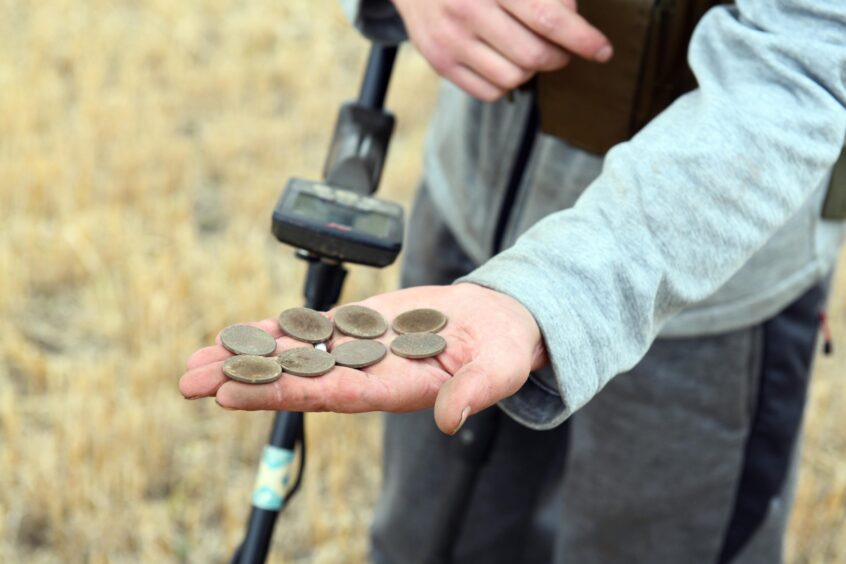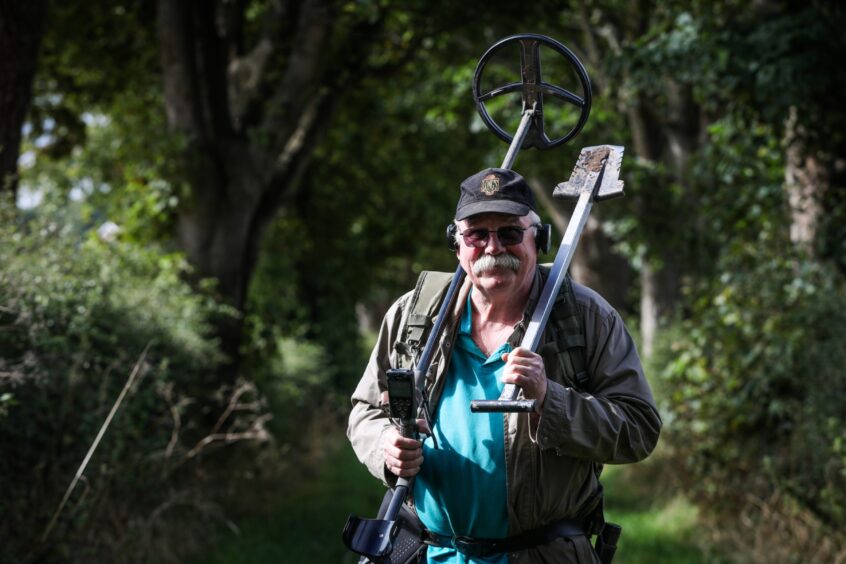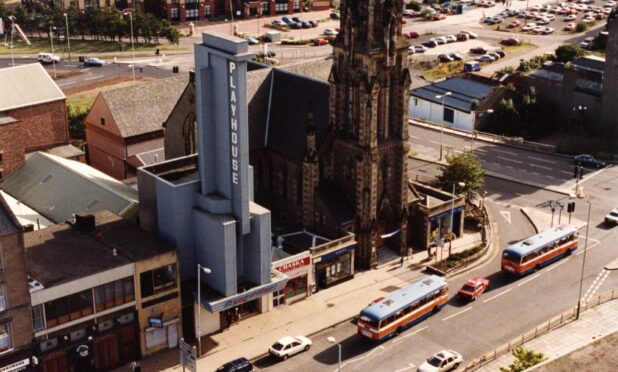The rolling stubble fields of Brucefield outside Ladybank in Fife may seem like an ordinary stretch of farmland to most passersby.
However, for the dedicated members of metal detecting club Alba Unearthed, these fields hold the tantalising promise of uncovering remnants of Scotland’s rich history.
The group recently gathered on a Sunday morning for another day of discovery and camaraderie – and The Courier was invited along to find out more.
Metal detector man behind Alba Unearthed
Scott Cunningham, a 30-year-old fencing contractor and father of three from Glenrothes, has been the driving force behind Alba Unearthed for the past six years.
The group, which has been active for about a decade, was originally established by metal-detectorist Derek McLennan, who famously discovered the Viking-age Galloway Hoard, in Kirkcudbrightshire in 2014.
Described as one of the most important UK archaeological finds of the century, experts revealed just the other week that part of this famous collection came from West Asia.
Scott, who took the reins from McLennan, has grown the club into a tight-knit community of hobbyists and history buffs, all united by the thrill of the hunt.
Speaking to The Courier in the middle of a stubble field as he took a break from detecting, he explained how his journey into metal detecting began almost by accident.
“I got into it about eight years ago,” he said.
“A guy I knew from work was into metal detecting and had found a 400-year-old gold coin. I couldn’t believe it. He showed me a picture, and I was hooked.”
Scott soon bought his first detector, a budget model from a local store, but quickly upgraded it to more sophisticated equipment as his interest grew.
Despite nearly a decade of searching, he laughs that he has yet to find his own piece of gold, though he’s uncovered plenty of silver and other fascinating artefacts.
“One day, I dream of finding a gold coin,” he says with a laugh.
“Anything gold! Just to finish off my display cabinet.”
The thrill of the metal detector dig
The dig at Brucefield was the culmination of months of planning and negotiation.
Scott had long been eyeing these fields. He’d driven past them numerous times on his way to and from Dundee.
He explained that what he normally does is knock on the farmer’s door and ask for permission.
If they’re interested, they set up a dig and share the proceeds with the landowner.
Seeking permission is vital after heritage watchdogs recently feared a surge in amateur metal detection during lockdown was jeopardising Scotland’s buried treasure.
Participants are also trusted by Scott to be honest about what they find.
Rich tapestry of discovery
On this particular Sunday, 21 members of Alba Unearthed are spread out over 28 acres of farmland, their metal detectors sweeping the ground in search of buried treasure.
The day’s finds included a musket ball, a Victorian halfpenny, a pocket watch dial, two Scottish bawbees and a George V threepence, all hinting at the rich tapestry of history hidden beneath the soil.
There’s particular excitement when a concentration of old Shillings are found beneath one of the tractor tramlines.
For Scott, it’s not just about the monetary value of the finds, but the stories they tell.
“This area used to be an ancient forest, and then a village was built in the 1830s,” he said, laughing that it’s also common for them to find a “load of trash”.
“The pocket watch dial we found might have belonged to a worker on the nearby railway line, and the coins were probably dropped by villagers.
“Every field has a story, and we’re just scratching the surface.”
The photographer who captures history
David Drummond, 63, from Broughty Ferry, has been a part of the metal-detecting community for over four decades.
Though arthritis has sidelined him from actively detecting, he now serves as the unofficial historian and photographer for Alba Unearthed, documenting each dig and the treasures uncovered.
Originally working in the family ironmongery business Ruthven P Smith in Broughty Ferry after leaving Arbroath High School, his passion for metal detecting began in 1978 when he was just 18 years old.
“I saw an article in the Evening Telegraph about the founding of the Dundee Metal Detecting Club,” he recalled.
“The idea of finding treasure, of uncovering the unknown, really appealed to me.”
Over the years, David has found everything from Bronze Age axes to medieval silver rings.
Many have been claimed by Treasure Trove Scotland, the Scottish legal body responsible for protecting the nation’s archaeological heritage.
He was there the day that teenage detectorist David Hall, from Livingston, famously discovered Roman hacksilver, now known as the Dairsie Hoard, at Dairsie, near Cupar, in 2014.
The silver was believed to have been used by Roman soldiers to bribe Picts while passing through Scotland in the 3rd century AD.
The most valuable item he’s personally found was a medieval silver ring in Fife.
He reveals he got just under £2,000 for it, but the real value was in the history.
“Holding something that hasn’t been touched in hundreds of years is an incredible feeling,” he said, adding that they often organise and take part in charity events.
David’s role at digs these days goes beyond photography.
He brings decades of experience and knowledge to the group, offering advice on identifying finds and navigating the often complex process of reporting them to Treasure Trove Scotland.
He explains that if someone finds something historically significant, they have 28 days to report it.
The joy of discovery
Both Scott and David emphasise that while metal detecting can sometimes be a solitary pursuit, the camaraderie of group digs makes it more rewarding.
“There’s a real sense of community here,” added Scott, as he shows off low-value items from previous digs in his car boot including bullets, musket balls and coins.
David agrees. “It’s not just about finding something valuable,” he said.
“It’s about being part of something bigger, contributing to our understanding of the past.”
The Brucefield finds, while modest compared to some of the legendary hoards uncovered in Scotland, are nonetheless valuable pieces of the historical puzzle.
The musket ball, for instance, offers a glimpse into the military activities that once took place in the area, while the coins tell of everyday life in a growing village.
David is particularly interested in the Scottish bawbee discoveries during this dig, including one found by David Anderson, 40, of West Wemyss.
This would have been a two pence piece in the 1670s.
“We can see a head on one side and on the other side we can see a thistle,” he said.
“That’s the sort of coin that would have been in Jacobites’ pockets later on.
“I’m also fascinated by a top from an early bottle of Claymore whisky, showing a Claymore Jacobite and sword.
“Normally, when you find these, they are all crushed and wrecked.
“This one probably dates from late 1800s/early 1900s. A fascinating find.”
Metal detector interest dates back to Brazil
Over in Monifieth, someone else who enjoys metal detecting is 72-year-old Garry Murrie.
He might be retired, but his days are far from idle.
With a lifetime of travel, craftsmanship and curiosity behind him, metal detecting combines his love for the outdoors with a penchant for history.
“I was a joiner by trade, worked all over England, and even spent 20 years in Brazil.
“But when I came back, I couldn’t get back into building, so I turned to craft work,” Garry said.
“Now I make spades for metal detecting and sell them on eBay. It’s a little living.”
Garry’s interest in metal detecting was sparked during his time in Brazil in the 1970s.
But it wasn’t until he settled in Monifieth that he truly embraced the hobby.
“I remember buying my first metal detector on eBay. I started on the beach, like most people do,” he said.
”The first challenge is choosing the right detector.
“They range from £300 to £3,000, and each one works differently. But once you get the hang of it, it’s addictive.”
The process of metal detecting is a blend of science, patience and a bit of luck.
Garry explains that a typical detector sends out a magnetic force that penetrates about nine inches into the ground.
It picks up metal objects and makes different noises depending on what it finds.
“It’s important to balance the detector to the ground you’re on. Different soils can affect what you detect,” Garry explained.
Discovery of swastikas in Angus
Over the years, Garry has uncovered a treasure trove of historical artefacts, some more surprising than others.
“One of the first things I found was a swastika at Balhungie Farm, near Monifieth,” he said.
“Turns out it was a symbol used by the Boy Scouts during World War I, long before it became associated with Nazi Germany.” The design was changed after the National Socialist Party adopted the symbol in Germany.
“Another time,” said Garry, “I found a 10lb bomb – I had to call the bomb squad for that one!” he recalls with a chuckle.
Despite the occasional brush with danger, it’s the historical intrigue that keeps Garry hooked.
“You learn a lot about history, like when I found musket balls at Fingask Castle,” he said.
“I found out that dragoon guards used the area for target practice centuries ago. It’s more about the adventure and the thrill of finding something with a story, rather than any financial gain.”
“It’s also a day out, away from the shed, out in the fresh air,” he added.
“That’s what I really enjoy.”
























Conversation